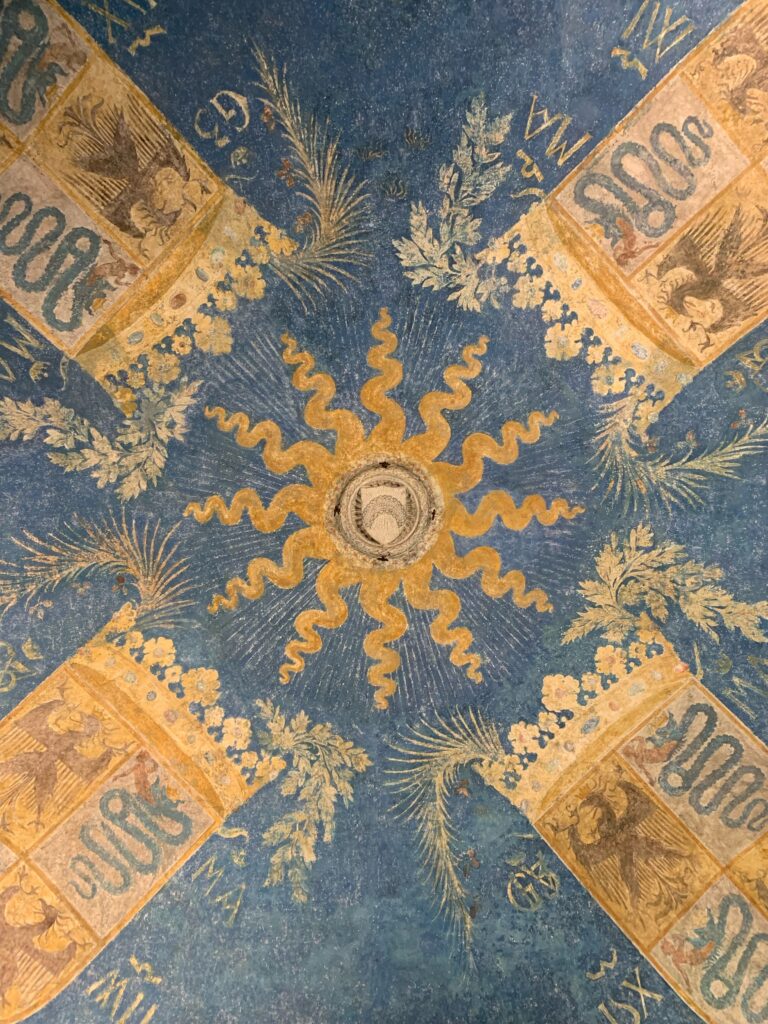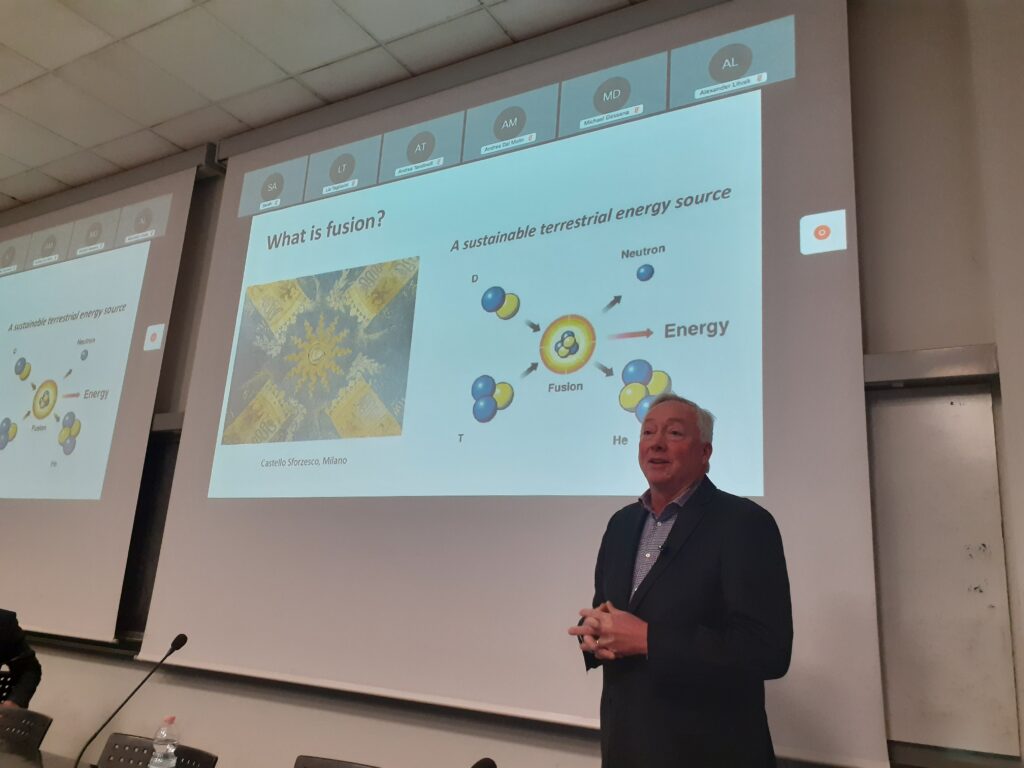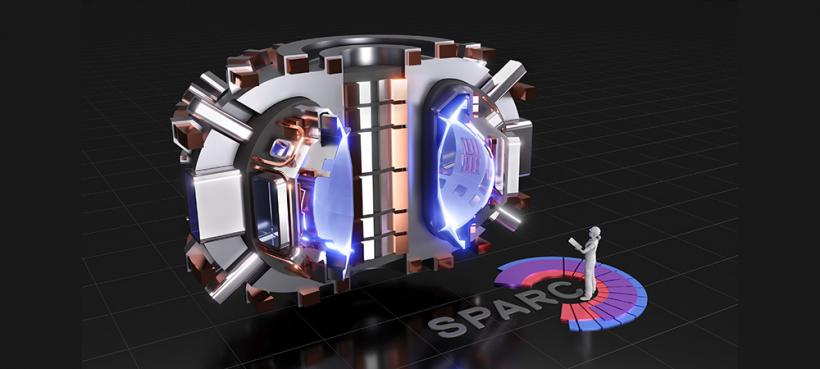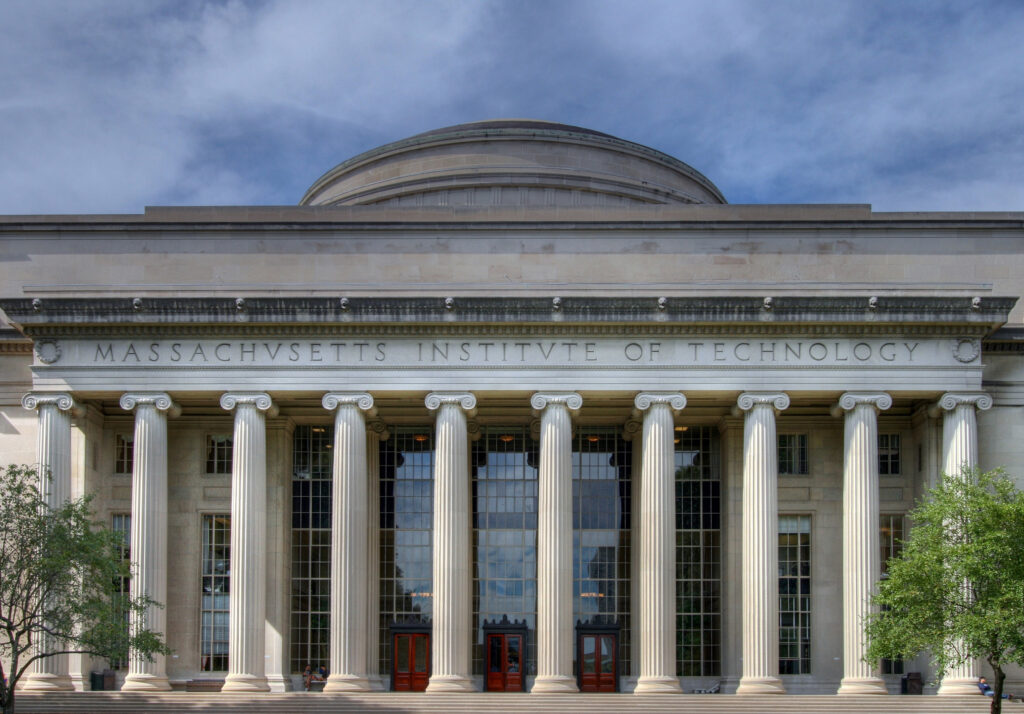We had the chance to meet Dennis Whyte, director of the MIT Plasma Science and Fusion Center, after his seminar at the Politecnico di Milano entitled “Fusion energy: what next?”. Dr Whyte has spent the last 35 years researching the production of fusion energy, is a professor at the Massachusetts Institute of Technology (MIT), has published over 350 papers, is also a professor of engineering at Hitachi America, a fellow of the American Physical Society and is the co-founder of Commonwealth Fusion Systems, a company which aims to supply the world with fusion energy. In a lecture hall packed with young students and many more connected remotely, he gave a quick and clear rundown from the basics of nuclear fusion to its current challenges. With a powerful and engaging voice, he captivated the audience from the very first image which showed a sun frescoed on the vaults of the Castello Sforzesco in Milan. We were excited by the idea of meeting this “brainiac” but he settled our nerves by greeting us with a wide smile and a firm handshake.

MEETING
Let’s start from the beginning. How did you discover your passion for research in this field?
It began a long time ago, I’ve always known that I wanted to do something to do with science discovery, because I love science discovery. It’s an amazing feeling when you’re seeing something for the first time that nobody else has seen yet. It’s like it’s addictive. But I also knew that I didn’t want to be just a pure scientist, working just for discovery itself. I always wanted to have a practical aspect to what I was doing. When I was an engineering physics student in Canada, I came across plasma fusion and for me it was a wonderful combination. Wow! (his blue eyes twinkle as he recalls his time as a student) It became clear that it could be one of the most fascinating careers because you can work across many different disciplines. I’ve worked in plasma physics, atomic physics, material science, even magnets science. I’ve been able to have five or six different really big careers in different areas of research. And this is also great for me because I love the ideas percolating across different areas and I hope that is reflected in my teaching, in my students and what we’re doing at MIT overall. In the end, fusion will not succeed because there’s one single brilliant physics idea, but because of teamwork that pulls together a practical energy system.
Has there been a decisive encounter in your career?
Oh, are you talking about Professor Skaarsgard? I always remember that meeting because I wasn’t sure what I was going to do. I had recently accepted a job in the oil industry and I was excited. But then I took this plasma course and after an interesting lesson I went to see my professor and he suggested working on this new experiment they were starting in Montreal. I was from the western part of Canada, my mother was Canadian, and that five-minute meeting changed my life. Since then, my rule has been to never turn down a meeting with students, ever. Which is hard sometimes because of my schedule, but I always want to make sure I’m interacting with them well. It’s a really privileged experience and a huge responsibility to be a professor, because you are a guide for them.
Could you explain what nuclear fusion is in simple terms, like you did this morning with the students?
(Laughing) Please don’t ask me to do the lecture again!!
Fusion is a fundamental energy source of the universe because it’s what powers the sun and also all stars. What it does is take the most abundant element that we have, which is hydrogen in its various isotopes (deuterium and tritium), and it fuses them together to change it into helium. And when that happens, it releases staggering amounts of energy. This means that if you use it as an energy source, you have a much greater ability to make energy from the same amount of fuel as anything that’s chemical, such as burning coal, gas, petrol or anything. It’s about 10 million times more. That is why we’ve pursued fusion energy research. Because theoretically it is an energy source which can be carbon free and inherently safe, yet simultaneously it can actually provide energy to all humans.

So, what are the advantages of this energy?
First of all, it’s a win for the climate. Climate change is so hard because something like 85% of the energy we use is produced by burning carbon through a chemical process. The effects of that such as CO2 emissions and pollution are very hard to keep under control. The hard part is replacing something which is relatively easy to do: you pull hydrocarbons out of the ground and then you burn them. Most people don’t understand how hard decarbonising and fighting climate change is. They think it’s simple to convert our electricity system to wind, solar or renewables. That’s only 20% of the problem. You have to decarbonise transportation, long range transport, air travel, cement production, the maritime shipping industry, our buildings, agriculture… Fossil fuels have basically powered all of that for almost the entire industrial revolution. How do we replace that? Oh, oh (spreading his arms) I work on this problem intensely and I still don’t understand how hard it is. Fusion provides a solution to all of this: it’s not an electricity source, it’s a fundamental and new energy source.
What scientific results have been achieved so far?
The scientific results have been spectacularly successful in fusion, and this goes back to when research started in the late 1950s. Together with another colleague at MIT, professor Rob Parker, we realised that we had to make an entire new discipline of science which was around fusion science, the containment of the plasma, its stability, all its properties because we knew almost nothing about it. We did that but it took a little while, and we eventually found these different configurations that were able to make what sounds almost like science fiction, right? In the late 1960s we were able to make 10 million degree plasma then by the middle of the 1970s we were making 100 million degree plasma and we were starting to contain them and starting to understand their limits. It was extraordinary progress (his eyes widen in awe at the progress made!) And now we have computer simulations which are able to understand the very complex processes that happen in this fuel state of the plasma. We’ve made real fusion energy. There’s a recent record that was just set in the United Kingdom for making 59,000,000 joules of fusion energy, surpassing the temperatures at the centre of the sun. Wow, that is a great scientific achievement.
Can you tell us about the SPARC project?
So, the SPARC project has already started, we’re building it already and we hope to have it operational in the middle of the decade and it’s going to play a key role and do two things: one is to demonstrate the ability of the plasma to produce more fusion power than the heat that’s required to keep the plasma hot. Our aim is to succeed in producing much more fusion power than the heat that’s required. This also means that the plasma becomes like a star, self-determined, so that its own heat maintains its properties and the properties produce the fusion and the fusion produces the heat. In scientific terms we call this a “coupled system”. But there’s another mission, which is to show the integrated technology on a large scale. That everyone can understand that fusion energy is ready to take the next step towards commercialisation and that means that it can produce fairly large amounts of power in a fairly compact device.

How long will that take?
The idea is to start operations in 2025/2026. SPARC is being built by the company that was spun out from MIT, Commonwealth Fusion Systems. The idea is that we turn this on and start operating it. We are working on the details of the research plan for that very quickly. We’re building on the experience that has come from scientific investigation, from the JET tokamak in the UK that just set the record we mentioned before, and the experiment we ran at MIT. We are copying certain parts but then adding this new ingredient which is the possibility of obtaining net energy from the plasma. Of course, the other new ingredient is these superconducting magnets which are what actually allow SPARC to be built, but are also the stepping stone towards commercial viability for fusion.

Can a comparison be made between ITER (International Thermonuclear Experimental Reactor) and SPARC?
ITER and SPARC are very complementary because they’re both after much of the same science mission, but ITER is significantly larger than SPARC because it uses the previous generation of magnet technology, but it was a vital contributor to SPARC because it was the world planning the science of ITER which allowed us to design SPARC very quickly, so there was an interesting complementarity. My own view of ITER is that it’s a wonderful science experiment. It’s more difficult, it isn’t being built as the idea of a commercial entity. It’s being built by governments, so its primary mission is one of science, but it will still provide important answers as to what we’re thinking for our fusion energy systems.
Is Italy involved in this project?
Yes, in particular at the beginning it was an idea that we had that the company would spin out from MIT, with the idea that if our goal was rapid commercialisation, it should do this through private investment. But we also had to look to see if we could find the right partners in industry because delivering fusion energy is not just science, it takes a whole energy ecosystem. ENI has been there since the beginning because of a long-standing research relationship with MIT, but when they saw our idea, they realised that this could also be part of the longer-term energy plans. They were one of the first investors in the company and they’ve also directly sponsored research at MIT which is looking towards making the eventual product more economically attractive. For me this is a leading example of the fact that energy companies need to be looking towards these carbon free solutions, because the challenge is that 85% of our energy is going to be switched from carbon-based supplies to carbon-free sources. (Wow) it’s very hard, so it’s going to take a big effort. It will need universities like MIT to create the talent and the new ideas. It’s going to take a new kind of industry to be able to build fusion technologies, but it’s also going to take companies like ENI because we’re going to need the infrastructure which comes from delivering energy on a large scale. It’s an exciting combination. Yeah, and now this connection to Italy is growing because there’s a new experiment that’s being built at Frascati with ENEA and we also have collaborations with other universities around Italy. Yeah, that’s great!
Speaking of students, what advice would you give them?
I’d like to close the circle back to my own time when I was a student and how fusion was something we did out of curiosity back then. The most exciting part of what’s going on now is probably that I can see the attitude differences of students, which comes from two things. One is the urgency of climate change which wasn’t there when I was a student. The motivation of students getting into something that they think could make a difference is very motivating to me. And then I think the second part is that it’s not just the company that we launched, but the fact that there are over 20 private sector fusion companies. Because they realise that there will have to be commercial products. I almost wish that I was a student again now…yes, because they have even more than what I had. I think that most young people really want to do things that have a positive impact on society, that’s what my hope is. Unfortunately, I can’t take a pill and go back to being 22 years old, but really we have an obligation to provide these opportunities to students because it’s going to take more young people and more great ideas. What you saw come out of the talk this morning in the lecture hall with the students is my greatest pride, because that project was designed by students and postdocs at MIT, because they bring not just enthusiasm, but an urgency that was honestly lacking in the older generation of fusion scientists. My greatest accomplishment was trusting young people, to actually take a bigger leadership role and be able to carry those forward.
Video of the complete seminar “Fusion energy: what next?” at this link
